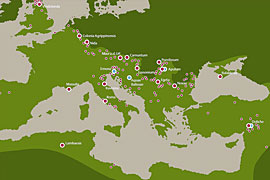(C9) Competition and Identity in Polytheistic Societies in Ancient Asia Minor

The significant Roman cult of Iuppiter Dolichenus was the object of enquiry during the first stage of funding. The focus of attention was on the long neglected question of how his native sanctuary in Northern Syria emerged and developed, and on the role it played in a local, regional and supraregional context. The analysis of the archaeological investigations in Doliche itself and regional cultural work in South-East Turkey were important basic elements of these works. It became apparent that the cult of Dolichenus, in contrast to what had mostly been assumed, did not play a role, either in Commagene or Syria. In a regional context, he served only as a localised major deity with a small range. This did not even change during the cult’s heyday in the West. While Iuppiter Dolichenus had many a thousand admirers between Britain and the Black Sea, he was not worshipped by the local people in the Orient. All of the sparse evidence, much of which emerged only recently, is connected with the Roman military and has to be seen as a backflow from the West. This finding is of major importance for the question as to what triggered the globalisation of the cult. It removes the foundation of the thesis of a dissemination by the “Syrians”. The activating impulse may have originated in Doliche alone or it may have emanated from the citizens of Doliche. This is surprising when taking into account the minor importance of the location within the Roman province. However, it remains an open question as to what it was that turned the situation around, enabling a deity of locally restricted power to eventually play such an important role as aeternus conservator totius mundi along the borders of the empire for several decades. The close connection of the god to the Roman emperor, which is programmatically staged in diverse versions on the town’s seal, suggests an official accordance of privileges by the Roman state. However, neither the cause nor the circumstances of such a measure can be extrapolated.
At any rate, in the diaspora, Dolichenus lost the constitutive local nature he had in his native region, became a deus commagenus and was globalised in the form of a group religion. He now became attractive for all Syrians in the Roman Empire as they could, in general terms, recognise him as a native god. Above all, everybody could as a matter of principle participate in the cultic community, which formed an open social network. However, our analyses suggest this development towards a group religion was not headed by the sanctuary in Doliche. On the contrary, the cult in Doliche retained its traditional and local nature to a great extent.

